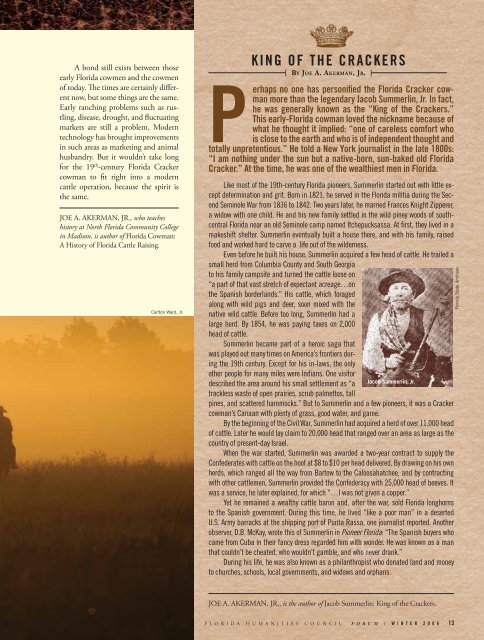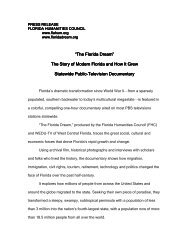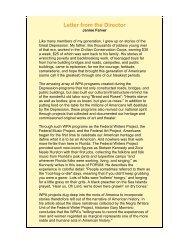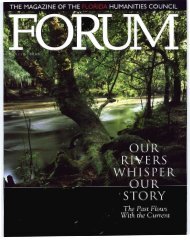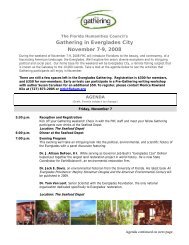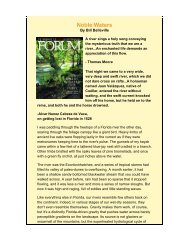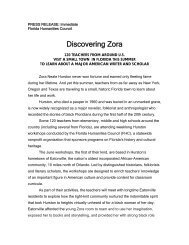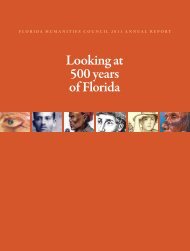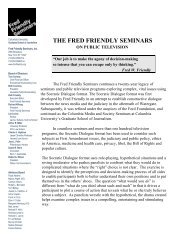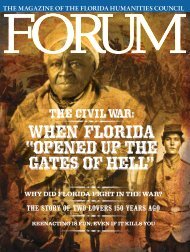THE MAGAZINE OF THE FLORIDA HUMANITIES COUNCIL
THE MAGAZINE OF THE FLORIDA HUMANITIES COUNCIL
THE MAGAZINE OF THE FLORIDA HUMANITIES COUNCIL
Create successful ePaper yourself
Turn your PDF publications into a flip-book with our unique Google optimized e-Paper software.
A bond still exists between those<br />
early Florida cowmen and the cowmen<br />
of today. The times are certainly different<br />
now, but some things are the same.<br />
Early ranching problems such as rustling,<br />
disease, drought, and fluctuating<br />
markets are still a problem. Modern<br />
technology has brought improvements<br />
in such areas as marketing and animal<br />
husbandry. But it wouldn’t take long<br />
for the 19 th -century Florida Cracker<br />
cowman to fit right into a modern<br />
cattle operation, because the spirit is<br />
the same.<br />
JOE A. AKERMAN, JR., who teaches<br />
history at North Florida Community College<br />
in Madison, is author of Florida Cowman:<br />
A History of Florida Cattle Raising.<br />
Carlton Ward, Jr.<br />
KING <strong>OF</strong> <strong>THE</strong> CRACKERS<br />
[ By Joe a. akerman, Jr. ]<br />
Perhaps no one has personified the Florida Cracker cowman<br />
more than the legendary Jacob Summerlin, Jr. In fact,<br />
he was generally known as the “King of the Crackers.”<br />
This early-Florida cowman loved the nickname because of<br />
what he thought it implied: “one of careless comfort who<br />
is close to the earth and who is of independent thought and<br />
totally unpretentious.” He told a New York journalist in the late 1800s:<br />
“I am nothing under the sun but a native-born, sun-baked old Florida<br />
Cracker.” At the time, he was one of the wealthiest men in Florida.<br />
Like most of the 19th-century Florida pioneers, Summerlin started out with little except<br />
determination and grit. Born in 1821, he served in the Florida militia during the Second<br />
Seminole War from 1836 to 1842. Two years later, he married Frances Knight Zipperer,<br />
a widow with one child. He and his new family settled in the wild piney woods of southcentral<br />
Florida near an old Seminole camp named Itchepucksassa. At first, they lived in a<br />
makeshift shelter. Summerlin eventually built a house there, and with his family, raised<br />
food and worked hard to carve a life out of the wilderness.<br />
Even before he built his house, Summerlin acquired a few head of cattle. He trailed a<br />
small herd from Columbia County and South Georgia<br />
to his family campsite and turned the cattle loose on<br />
“a part of that vast stretch of expectant acreage…on<br />
the Spanish borderlands.” His cattle, which foraged<br />
along with wild pigs and deer, soon mixed with the<br />
native wild cattle. Before too long, Summerlin had a<br />
large herd. By 1854, he was paying taxes on 2,000<br />
head of cattle.<br />
Summerlin became part of a heroic saga that<br />
was played out many times on America’s frontiers during<br />
the 19th century. Except for his in-laws, the only<br />
other people for many miles were Indians. One visitor<br />
described the area around his small settlement as “a<br />
trackless waste of open prairies, scrub palmettos, tall<br />
Jacob Summerlin, Jr.<br />
pines, and scattered hammocks.” But to Summerlin and a few pioneers, it was a Cracker<br />
cowman’s Canaan with plenty of grass, good water, and game.<br />
By the beginning of the Civil War, Summerlin had acquired a herd of over 11,000 head<br />
of cattle. Later he would lay claim to 20,000 head that ranged over an area as large as the<br />
country of present-day Israel.<br />
When the war started, Summerlin was awarded a two-year contract to supply the<br />
Confederates with cattle on the hoof at $8 to $10 per head delivered. By drawing on his own<br />
herds, which ranged all the way from Bartow to the Caloosahatchee, and by contracting<br />
with other cattlemen, Summerlin provided the Confederacy with 25,000 head of beeves. It<br />
was a service, he later explained, for which “…I was not given a copper.”<br />
Yet he remained a wealthy cattle baron and, after the war, sold Florida longhorns<br />
to the Spanish government. During this time, he lived “like a poor man” in a deserted<br />
U.S. Army barracks at the shipping port of Punta Rassa, one journalist reported. Another<br />
observer, D.B. McKay, wrote this of Summerlin in Pioneer Florida: “The Spanish buyers who<br />
came from Cuba in their fancy dress regarded him with wonder. He was known as a man<br />
that couldn’t be cheated, who wouldn’t gamble, and who never drank.”<br />
During his life, he was also known as a philanthropist who donated land and money<br />
to churches, schools, local governments, and widows and orphans.<br />
JOE A. AKERMAN, JR., is the author of Jacob Summerlin: King of the Crackers.<br />
FFLLO O RRI ID D A A H U M AAN N I ITTI IEES S C O U N C I IL L FFO O RRU U M / / WWI INNT TE ER R 220 00 06 6 13<br />
1<br />
Florida State Archives


